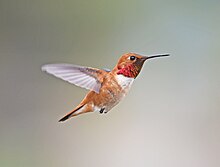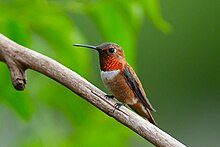Rufous hummingbird
| Rufous hummingbird | |
|---|---|

| |
| Male in hovering flight | |
| Scientific classification | |
| Domain: | Eukaryota |
| Kingdom: | Animalia |
| Phylum: | Chordata |
| Class: | Aves |
| Clade: | Strisores |
| Order: | Apodiformes |
| Family: | Trochilidae |
| Genus: | Selasphorus |
| Species: | S. rufus
|
| Binomial name | |
| Selasphorus rufus (Gmelin, JF, 1788)
| |

| |
Summer, breeding range Winter range
| |
The rufous hummingbird (Selasphorus rufus) is a small hummingbird, about 8 cm (3.1 in) long with a long, straight and slender bill. These birds are known for their extraordinary flight skills, flying 2,000 mi (3,200 km) during their migratory transits. It is one of nine species in the genus Selasphorus.
Taxonomy
The rufous hummingbird was formally described in 1788 by the German naturalist Johann Friedrich Gmelin in his revised and expanded edition of Carl Linnaeus's Systema Naturae. He placed it with all the other hummingbirds in the genus Trochilus and coined the binomial name Trochilus rufus.[3] Gmelin based his description on the ruff-necked hummingbird described by John Latham in 1782 and the ruffed honeysucker described by Thomas Pennant in 1785.[4][5]
The
Description

The adult male has a white breast, rufous face, flanks and tail and an iridescent orange-red throat patch or gorget. Some males have some green on their back and/or crown. The female has green, white, and some iridescent orange feathers in the center of the throat, and a dark tail with white tips and rufous base.
The female is slightly larger than the male. Females and the rare green-backed males are extremely difficult to differentiate from Allen's hummingbird. The typical "notched" shape of the second rectrix (R2) is considered an important field mark to distinguish the adult male rufous hummingbird from the adult male Allen's hummingbird.[10] This is a typical-sized hummingbird, being a very small bird. It weighs 2–5 g (0.071–0.176 oz), measures 7–9 cm (2.8–3.5 in) long and spans 11 cm (4.3 in) across the wings.[11]
Distribution and habitat

Western rufous hummingbirds migrate through the Rocky Mountains and nearby lowlands from May to September to take advantage of the wildflower season. They may stay in one local region for the entire summer, in which case the migrants (like breeding birds) often aggressively take-over and defend feeding locations. Most individuals winter in wooded areas in the Mexican state of Guerrero, traveling over 2,000 mi (3,200 km) by an overland route from their nearest summer home – a prodigious journey for a bird weighing only 3 to 4 grams (0.11 to 0.14 oz).[12]
Adult male rufous hummingbirds tend to migrate slightly earlier than females or young.[13] Since juveniles and females are essentially indistinguishable from Allen's hummingbird, unless confirmed by close inspection, eastern rufous migrants may be classified as "rufous/Allen's hummingbirds".[11]
Behavior and ecology
Food and feeding

They feed on nectar from flowers using a long extendable tongue or catch insects on the wing. These birds require frequent feeding while active during the day and become torpid at night to conserve energy. Because of their small size, they are vulnerable to insect-eating birds and animals.
Hovering and sexual dimorphism
A study that used
Both males and females are territorial; however, they defend different types of territories.[19] The more aggressive males fight to defend areas with dense flowers, pushing females into areas with more sparsely populated flowers.[19] Males generally have shorter wings than females, therefore their metabolic cost for hovering is higher. This allows males to beat their wings at high frequencies, giving them the ability to chase and attack other birds to defend their territory.[19] The metabolic cost of short wings is compensated for by the fact that these males do not need to waste energy foraging for food, because their defended territory provides plenty of sustenance.[20] Females on the other hand are not given access to the high concentration food sources, because the males fight them off.[19] Therefore, females generally defend larger territories, where flowers are more sparsely populated, forcing them to fly farther between food sources.[19] The metabolic cost of flying farther is compensated for with longer wings providing more efficient flight for females.[19] The differences in wing length demonstrate a distinct sexual dimorphism, allowing each sex to best exploit resources in an area.
Breeding
Their primary breeding habitats are open areas,
Conservation status
In 2018, the rufous hummingbird was uplisted from least concern to near threatened on the IUCN Red List, on the basis that due to its reliance on insect prey during the wintering season, it will be heavily affected by the global decline in insect populations due to pesticides and intensified agriculture.[21] Due to climate change, many flowers that the rufous hummingbird feeds on during the breeding season have started blooming two weeks prior to the birds' arrival to their breeding locations, which may lead to rufous hummingbirds arriving too late to feed on them.[21]
Gallery
-
Slow-motion video of rufous hummingbird attacking Anna's hummingbird at feeder. Video taken at 2000 fps, or about 1⁄67 of real-time.
-
Rufous hummingbird feeding in slow motion at 2000 fps or 1⁄67 of real-time.
References
- . Retrieved 18 November 2021.
- ^ "Appendices | CITES". cites.org. Retrieved 2022-01-14.
- ^ Gmelin, Johann Friedrich (1788). Systema naturae per regna tria naturae : secundum classes, ordines, genera, species, cum characteribus, differentiis, synonymis, locis (in Latin). Vol. 1, Part 1 (13th ed.). Lipsiae [Leipzig]: Georg. Emanuel. Beer. p. 497.
- ^ Latham, John (1782). A General Synopsis of Birds. Vol. 1, Part 2. London: Printed for Benj. White. p. 785, Plate 35.
- ^ Pennant, Thomas (1785). Arctic Zoology. Vol. 2. London, United Kingdom: Printed by Henry Hughs. p. 290.
- ^ Peters, James Lee, ed. (1945). Check-List of Birds of the World. Vol. 5. Cambridge, Massachusetts: Harvard University Press. p. 141.
- ^ Swainson, William John; Richardson, J. (1831). Fauna boreali-americana, or, The zoology of the northern parts of British America. Vol. Part 2. The Birds. London: J. Murray. p. 324. The title page bears the year 1831 but the volume did not appear until 1832.
- ^ Rasmussen, Pamela, eds. (January 2022). "Hummingbirds". IOC World Bird List Version 12.1. International Ornithologists' Union. Retrieved 12 July 2022.
- ISBN 978-1-4081-2501-4.
- OCLC 38593534.
- ^ a b c d "Rufous Hummingbird". All About Birds. Cornell Lab of Ornithology.
- ^ "Rufous Hummingbird Migration: Temperature, Patterns and Timing". Journey North. University of Wisconsin-Madison Arboretum. 2019. Retrieved 2021-03-18.
- ^ "Rufous Hummingbird". Audubon Guide to North American Birds. 2014-11-13. Retrieved 2021-03-18.
- ^ "Master fliers of the bird kingdom". BBC. 27 June 2005. Retrieved 30 October 2009.
- S2CID 110014894.
- S2CID 4427424.
- S2CID 81581157.
- S2CID 40843202.
- ^ JSTOR 1936374.
- S2CID 84567304.
- ^ a b BirdLife International (22 November 2018). "Red List update for birds" (PDF). BirdLife. Retrieved 23 November 2018.
External links
- Rufous hummingbird Species Account - Cornell Lab of Ornithology
- "Rufous hummingbird media". Internet Bird Collection.
- Rufous hummingbird photo gallery at VIREO (Drexel University)
- Interactive range map of Selasphorus rufus at IUCN Red List maps

